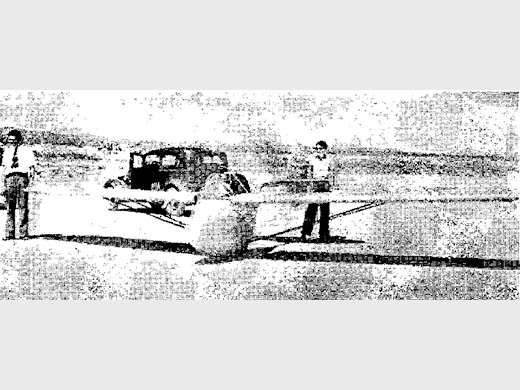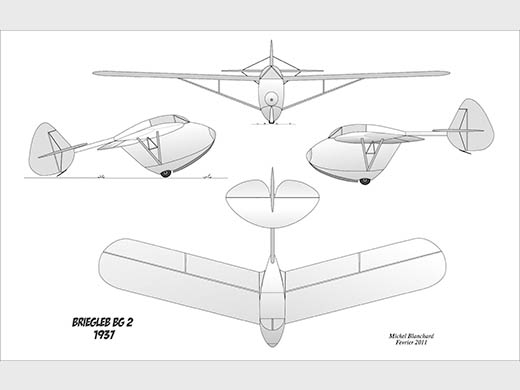
Briegleb BG-02
| DONNÉES GÉNÉRALES |
| Année du premier vol (ou de design, si seul projet) |
1937 |
| Pays | USA |
| Designer(s) | BRIEGLEB, William Gus & WALTERS, Donald E. |
| Premier constructeur | Briegleb Aircraft Company, Los Angeles, Cal, USA |
| Type d'appareil | Planeur |
| Fonction | Entraînement |
| SPÉCIFICATIONS TECHNIQUES |
| Envergure | 8.07 m |
| Longueur | 4.16 m |
| Hauteur | 1.82 m |
| Allongement | -- |
| Surface alaire | 8.13 m2 |
| Profil aile | -- |
| Masse à vide | 72.6 kg |
| Masse maxi | 158.75 kg |
| Charge alaire | -- |
| Vitesse mini | 41 km/h |
| Vitesse maxi | 144 km/h |
| Finesse maxi | |
| Taux de chute mini | -- |
| Nb sièges | 1 |
| Structure | Fuselage en tubes acier soudés. Aile bois et toile. |
AUTRES INFORMATIONS
| Constructeur(s) |
| ||||||
| Infos techniques | -- | ||||||
| Histoire résumée | An interesting new glider known as the Briegleb BG-2, a successor to the BG-1 Utility, has been completed by Briegleb Aircraft Company in Los Angeles. It was designed by William G. Briegleb, General Manager of the Company, and Mr. Donald E. Walters, its Chief Engineer. Flight tests have recently been completed at Rosemond Dry Lake. The BG-2 is a "shoulder-wing" design with sharply swept back wings equipped with flaps and boom tail. Fuselage and tail surfaces are of welded steel tube construction and wings are built up of wooden spars and ribs. V-struts, fastened above the bottom of the fuselage, form the wing bracing, and streamline wires brace the empennage. The most noteworthy feature of this ship is its small size. With a span of less than 27' it weighs in empty at 160 pounds. Mr. Briegleb states his purpose in designing this type of glider is five-fold. First, its small size enables it to be stored on its trailer in a 16' garage. Second, being small it does not require the work and materials of a larger ship, therefore the price can be kept low. Third, the upkeep will be low due to the small areas on the ship. Fourth, it can easily be handled and assembled on the field, and fifth, it can be towed by a small, low power car. The N.A.C.A. 2R12 Airfoil is used and the characteristics of this curve, together with the sweepback of the wings, give it good longitudinal stability, even with flaps all the way down. This enabled the designers to use a short fuselage. The first tests, in which the ship was towed to 2,000' in a three mile run on the dry lake bottom, were made with cockpit cover off and without wing root filleting. Subsequent flights have been made with the cover on, which greatly improved the performance. Additional improvement is expected when fillets are installed. The single wheel landing gear was found to be set too far back and this has been corrected. The tests of the flaps proved very satisfactory. With them one-third down the glider got off the ground quickly and had no pitching moment whatever. With the flaps pulled all the way down it descended very steeply, indicating that landings could be made in extremely small fields. The visibility from the cockpit is excellent and there is ample room, as is shown in the accompanying photograph. It should prove a very safe and practical glider for instruction and preliminary soaring. Advance estimates on the price are that it will be below $400.00 without flaps and not over $450.00 F. O. B. Los Angeles with them installed. | ||||||
| Liens personnalités | BRIEGLEB William Gustave (USA) | ||||||
| Compléments docs |
SOURCES DOCUMENTAIRES
| Liens WEB | Site : Briegleb's Aerodrome . Photo. (2014-11-11 CL) |
| Livres | Pas de livre référencé. |
| Autres sources | The new Briegleb utility, Soaring Magazine, juin 1937, texte + 3 photos + specs |

Team J2mcL © 2003 -
- Pages optimisées pour Mozilla Firefox

